Financial Accounting Assignment - LMS ltd
42 Pages4106 Words257 Views
Added on 2020-12-10
Financial Accounting Assignment - LMS ltd
Added on 2020-12-10
ShareRelated Documents
FINANCIAL ACCOUNTING
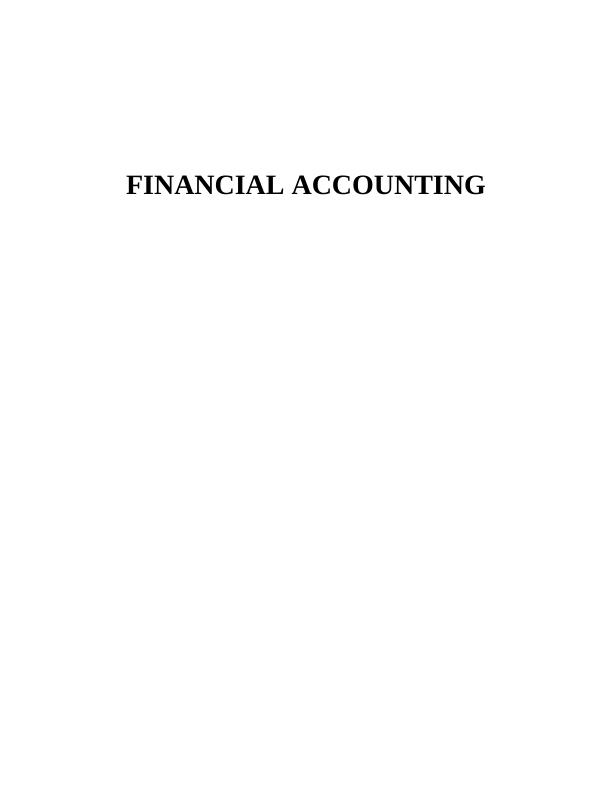
TABLE OF CONTENTS
INTRODUCTION...........................................................................................................................1
Financial accounting and its purpose..........................................................................................1
Regulations relating to financial accounting...............................................................................2
Accounting principles.................................................................................................................2
Accounting Conventions Concepts of consistency and materialistic disclosure........................4
CLIENT 1........................................................................................................................................4
1. Creating journal entries for business.......................................................................................4
.....................................................................................................................................................5
2. Ledger accounts......................................................................................................................6
3. Trial balance and purpose of its preparation.........................................................................21
CLIENT 2......................................................................................................................................22
1. Statement of Profit and Loss account....................................................................................22
2. Statement of Financial Position............................................................................................23
CLIENT 3......................................................................................................................................25
1. Statement of Profit & Loss account of LMS ltd..................................................................25
2. Financial Position statement of LMS ltd...............................................................................26
3. Concepts of Consistency and Prudency................................................................................28
4. Purpose of depreciation and methods of charging depreciation...........................................29
CLIENT 4......................................................................................................................................30
1. Bank reconciliation statement...............................................................................................30
2. Causes of variation accounting records with bank statements..............................................30
3. Cash book and Bank reconciliation statement of Kendal Ltd...............................................31
CLIENT 5......................................................................................................................................33
1. Sales and purchase ledger account of Henderson Ltd...........................................................33
CLIENT 6......................................................................................................................................35
1. Suspense account and its features.........................................................................................35
2.Trial balance ..........................................................................................................................36
3. Difference between clearing account and suspense account.................................................36
CONCLUSION..............................................................................................................................37
INTRODUCTION...........................................................................................................................1
Financial accounting and its purpose..........................................................................................1
Regulations relating to financial accounting...............................................................................2
Accounting principles.................................................................................................................2
Accounting Conventions Concepts of consistency and materialistic disclosure........................4
CLIENT 1........................................................................................................................................4
1. Creating journal entries for business.......................................................................................4
.....................................................................................................................................................5
2. Ledger accounts......................................................................................................................6
3. Trial balance and purpose of its preparation.........................................................................21
CLIENT 2......................................................................................................................................22
1. Statement of Profit and Loss account....................................................................................22
2. Statement of Financial Position............................................................................................23
CLIENT 3......................................................................................................................................25
1. Statement of Profit & Loss account of LMS ltd..................................................................25
2. Financial Position statement of LMS ltd...............................................................................26
3. Concepts of Consistency and Prudency................................................................................28
4. Purpose of depreciation and methods of charging depreciation...........................................29
CLIENT 4......................................................................................................................................30
1. Bank reconciliation statement...............................................................................................30
2. Causes of variation accounting records with bank statements..............................................30
3. Cash book and Bank reconciliation statement of Kendal Ltd...............................................31
CLIENT 5......................................................................................................................................33
1. Sales and purchase ledger account of Henderson Ltd...........................................................33
CLIENT 6......................................................................................................................................35
1. Suspense account and its features.........................................................................................35
2.Trial balance ..........................................................................................................................36
3. Difference between clearing account and suspense account.................................................36
CONCLUSION..............................................................................................................................37
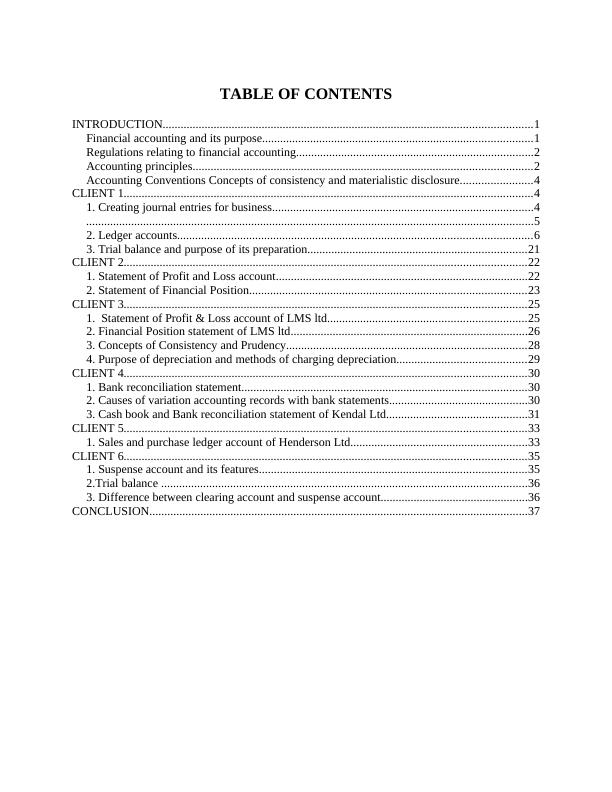
REFERENCES..............................................................................................................................38

INTRODUCTION
TASK A
1.Financial accounting and its purpose
Accounting provides information’s related to economic position of company and assists
to take decisions accordingly. It can also be determined as the process of identifying, measuring
and keeping economic transactions recorded in books. This report is considered as a financial
report of firm. This activity helps to estimate correct financial status of business (Robson,Young,
and Power, 2017).
This basically works on the guidelines of GAAP. Financial report shows actual
performance of business enterprise to investors of company. Here revenues and all expenses of
the entity is clearly represented in terms of actual monetary figure. Correct accounting reports
shows sound financial status of the industry. Financial reports can be maintained by preparing
balance sheet, income statements, cash flow etc. and this reports can be well-kept by the process
of recording day to day monetary transactions of business. Correct estimated values of assets and
liabilities needs to be known to entity so that they prepare appropriate financial data (Beatty and
Liao, 2014).
Purpose of financial accounting
Purpose of accounting information is to collect, store and record transactions to produce
appropriate figures of monetary information. There are various kinds of statements that needs to
be prepared by firm. Purpose of preparing these accounting statements is described as below:
Income statements
This is termed as earnings of the company. The purpose of preparing this record is to
show actual income and expenditure of business unit. It helps in identifying unnecessary
expenditure so manager can take right decisions to minimize cost (Robson,Young, and Power,
2017).
Balance sheet
This is yearly financial status of business entity. It has a purpose of maintaining
information in fixed period. (Robson,Young and Power, 2017).
Cash flow statements
TASK A
1.Financial accounting and its purpose
Accounting provides information’s related to economic position of company and assists
to take decisions accordingly. It can also be determined as the process of identifying, measuring
and keeping economic transactions recorded in books. This report is considered as a financial
report of firm. This activity helps to estimate correct financial status of business (Robson,Young,
and Power, 2017).
This basically works on the guidelines of GAAP. Financial report shows actual
performance of business enterprise to investors of company. Here revenues and all expenses of
the entity is clearly represented in terms of actual monetary figure. Correct accounting reports
shows sound financial status of the industry. Financial reports can be maintained by preparing
balance sheet, income statements, cash flow etc. and this reports can be well-kept by the process
of recording day to day monetary transactions of business. Correct estimated values of assets and
liabilities needs to be known to entity so that they prepare appropriate financial data (Beatty and
Liao, 2014).
Purpose of financial accounting
Purpose of accounting information is to collect, store and record transactions to produce
appropriate figures of monetary information. There are various kinds of statements that needs to
be prepared by firm. Purpose of preparing these accounting statements is described as below:
Income statements
This is termed as earnings of the company. The purpose of preparing this record is to
show actual income and expenditure of business unit. It helps in identifying unnecessary
expenditure so manager can take right decisions to minimize cost (Robson,Young, and Power,
2017).
Balance sheet
This is yearly financial status of business entity. It has a purpose of maintaining
information in fixed period. (Robson,Young and Power, 2017).
Cash flow statements
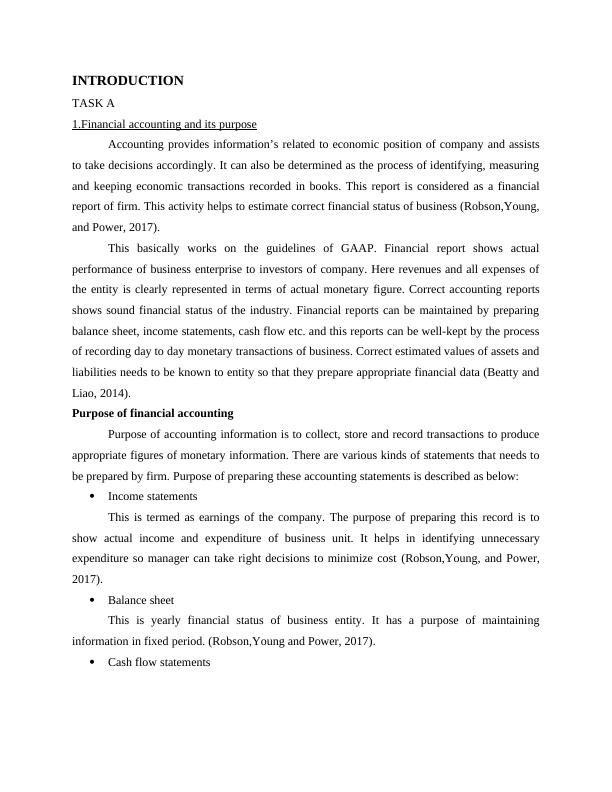
These statements are described as inflows and outflows of the cash within a financial
year. Purpose of these reports is to obtain appropriate information about cash in company
(Beatty, and Liao, 2014).
Statement of retained earning
This is a final statement of profits earned by the firm. This statement serves as
accumulated amount of profits in business.
2.Regulations relating to financial accounting
Some requirements are proposed to regulate functioning of financial accounting. In
simple words, we can say that these are rules and regulations of preparing accounts for entity.
There are some standards and principles developed by government. So accounting management
has to follow some rules and regulations to perform financial activities in the organization. The
financial reporting council (FRC) in UK has power to supervise and regulate these functions. In
1990, Accounting standard committee (ASC) developed principles to guide standards under
Company act of 1985 (Beatty, and Liao, 2014).
IASB (International Accounting Standard Board)
It was introduced in April 2001, and this standard has a complete independent
international structure based on the standardized framework of economic status. IASB concept is
based on recommendations of a report produced by standard committee under guidance of Ron
Dearing CB (Chairman of committee). The board has appointed IASB members to look after
accounting practices and they also raise funds needed by organization.
IFRS (International financial Reporting Standard)
This also has important role in providing framework to accounting practices. This
standard provides investers to extract appropriate position of the company and ease their decision
making (Beatty, and Liao, 2014). Some guidelines which are widely followed while preparing
financial accounting statements of the company known as GAAP. Generally Accepted
Accounting Principles (GAAP) are conceptual methods of applying accounting standards in
entity.
year. Purpose of these reports is to obtain appropriate information about cash in company
(Beatty, and Liao, 2014).
Statement of retained earning
This is a final statement of profits earned by the firm. This statement serves as
accumulated amount of profits in business.
2.Regulations relating to financial accounting
Some requirements are proposed to regulate functioning of financial accounting. In
simple words, we can say that these are rules and regulations of preparing accounts for entity.
There are some standards and principles developed by government. So accounting management
has to follow some rules and regulations to perform financial activities in the organization. The
financial reporting council (FRC) in UK has power to supervise and regulate these functions. In
1990, Accounting standard committee (ASC) developed principles to guide standards under
Company act of 1985 (Beatty, and Liao, 2014).
IASB (International Accounting Standard Board)
It was introduced in April 2001, and this standard has a complete independent
international structure based on the standardized framework of economic status. IASB concept is
based on recommendations of a report produced by standard committee under guidance of Ron
Dearing CB (Chairman of committee). The board has appointed IASB members to look after
accounting practices and they also raise funds needed by organization.
IFRS (International financial Reporting Standard)
This also has important role in providing framework to accounting practices. This
standard provides investers to extract appropriate position of the company and ease their decision
making (Beatty, and Liao, 2014). Some guidelines which are widely followed while preparing
financial accounting statements of the company known as GAAP. Generally Accepted
Accounting Principles (GAAP) are conceptual methods of applying accounting standards in
entity.
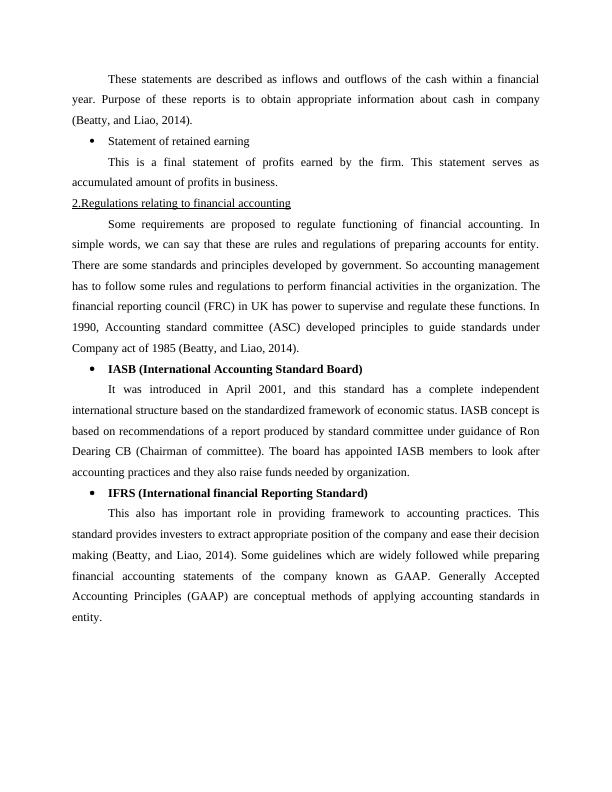
3.Accounting principles22 GAAP has provided some basic guidelines. These principles are major attempts to
maintain consistency in making yearly financial reports. An accountant can analyze
yearly statements and compare company's current revenues or losses with the previous
year reports. This helps to get exact accounting information of year (Beatty, and Liao,
2014). Some Generally Accepted Accounting Principles are described below:1. Economic Entity Assumptions:
The business accounts and transactions of the individuals needs to be differentiated from
its owner. Or keeping business records separated with the personal (Macve, 2015).
2. Monetary Unit Assumption
Management needs to record only those transactions which can be expressed only in
terms of monetary expenses.3. Time Period Assumption
Here needs to be a fixed and decided time period of reporting the financial data to the
owner of the enterprise (Macve, 2015).4. Cost Principle
Assets and Liabilities of business needs to be recorded with correct figure at which they
are bought or sold currently.5. Full Disclosure Principle
Any information related to business activities needs to be disclosed properly while
maintaining business data (Robson,Young, and Power, 2017).6. Going Concern Principle
This concept tells us about assumptions related to existence of business in the future.
This principle helps to differentiate prepaid expenses with future accounting periods (Beatty and
Liao, 2014).7. Matching Principle
Each revenue recorded required to be matched with expenses related to it, at time of its
occurrence.8. Revenue Recognition Principle
Company needs to record its revenue generating transaction at the time of their
happening (Weygandt, Kimmel and Kieso 2015).
3
maintain consistency in making yearly financial reports. An accountant can analyze
yearly statements and compare company's current revenues or losses with the previous
year reports. This helps to get exact accounting information of year (Beatty, and Liao,
2014). Some Generally Accepted Accounting Principles are described below:1. Economic Entity Assumptions:
The business accounts and transactions of the individuals needs to be differentiated from
its owner. Or keeping business records separated with the personal (Macve, 2015).
2. Monetary Unit Assumption
Management needs to record only those transactions which can be expressed only in
terms of monetary expenses.3. Time Period Assumption
Here needs to be a fixed and decided time period of reporting the financial data to the
owner of the enterprise (Macve, 2015).4. Cost Principle
Assets and Liabilities of business needs to be recorded with correct figure at which they
are bought or sold currently.5. Full Disclosure Principle
Any information related to business activities needs to be disclosed properly while
maintaining business data (Robson,Young, and Power, 2017).6. Going Concern Principle
This concept tells us about assumptions related to existence of business in the future.
This principle helps to differentiate prepaid expenses with future accounting periods (Beatty and
Liao, 2014).7. Matching Principle
Each revenue recorded required to be matched with expenses related to it, at time of its
occurrence.8. Revenue Recognition Principle
Company needs to record its revenue generating transaction at the time of their
happening (Weygandt, Kimmel and Kieso 2015).
3

9. Materiality
Consideration of all the materialistic things if it is effecting the company's accounting
data (Henderson, 2015).10. Reliability Principle
This guideline tells us about deciding that which financial information is to be displayed
in the records (Macve, 2015).
4.Accounting Conventions Concepts of consistency and materialistic disclosure
It refers to avoiding fraud activities in the business enterprise. It determines high
performance of the business with low cost incurred in it. Conventions includes those traditions or
customs which influences final statements while preparing financial accounting. Preparation for
security solution of company needs to be preplanned. Book-keeping method needs to be used for
maintaining accounts in the company (Renz, 2016).
Consistency implies of keeping records timely retained. This helps to compare previously
occurred activities with current performance in the organization. Ultimately, this renders
business entities to take decisions regarding methods or guidelines to be followed further
(Henderson, 2015). For example, better technique of depreciation needs to be chosen on assets
whether it is fixed or diminished method (Macve, 2015).
Materiality disclosure refers to maintaining only that information which is necessary for
the business to be focused on. Non materialistic events required to be ignored. This principle is
applied because there is no need to overburden the accounting activities by recording
unnecessary information (Warren and Jones, 2018).
CLIENT 1
1. Creating journal entries for business
A journal entry is a method which is used to record accounting transaction of a business.
Analyzing and recording of transactions into journal entries is the foremost step in accounting
process. It is detailed record of transactions related to money. Transactions are analyzed,
recorded and summarized in order to know true position of company. Every transaction in
journal have equal debit and credit amount with time, date and description of such events.
Entries are recorded in a chronological order (Hines, 1988). The journal entries of company are:
-
4
Consideration of all the materialistic things if it is effecting the company's accounting
data (Henderson, 2015).10. Reliability Principle
This guideline tells us about deciding that which financial information is to be displayed
in the records (Macve, 2015).
4.Accounting Conventions Concepts of consistency and materialistic disclosure
It refers to avoiding fraud activities in the business enterprise. It determines high
performance of the business with low cost incurred in it. Conventions includes those traditions or
customs which influences final statements while preparing financial accounting. Preparation for
security solution of company needs to be preplanned. Book-keeping method needs to be used for
maintaining accounts in the company (Renz, 2016).
Consistency implies of keeping records timely retained. This helps to compare previously
occurred activities with current performance in the organization. Ultimately, this renders
business entities to take decisions regarding methods or guidelines to be followed further
(Henderson, 2015). For example, better technique of depreciation needs to be chosen on assets
whether it is fixed or diminished method (Macve, 2015).
Materiality disclosure refers to maintaining only that information which is necessary for
the business to be focused on. Non materialistic events required to be ignored. This principle is
applied because there is no need to overburden the accounting activities by recording
unnecessary information (Warren and Jones, 2018).
CLIENT 1
1. Creating journal entries for business
A journal entry is a method which is used to record accounting transaction of a business.
Analyzing and recording of transactions into journal entries is the foremost step in accounting
process. It is detailed record of transactions related to money. Transactions are analyzed,
recorded and summarized in order to know true position of company. Every transaction in
journal have equal debit and credit amount with time, date and description of such events.
Entries are recorded in a chronological order (Hines, 1988). The journal entries of company are:
-
4
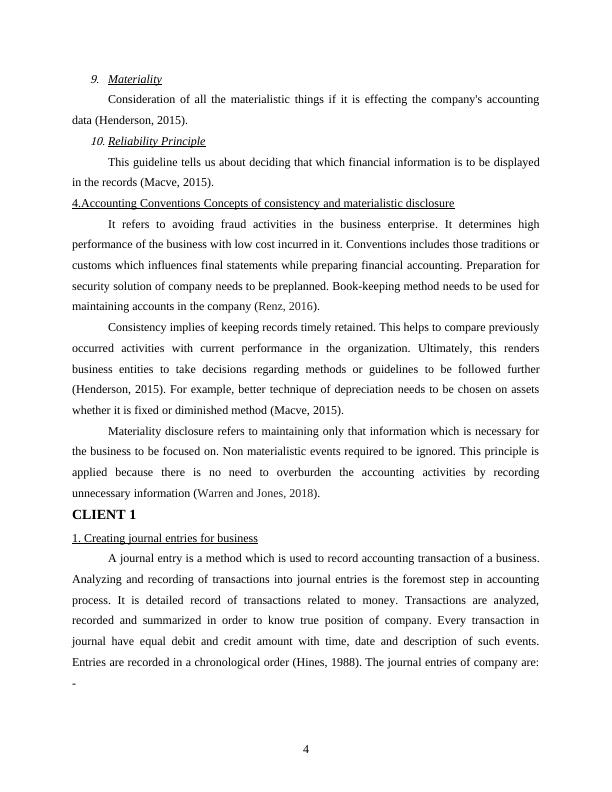
5
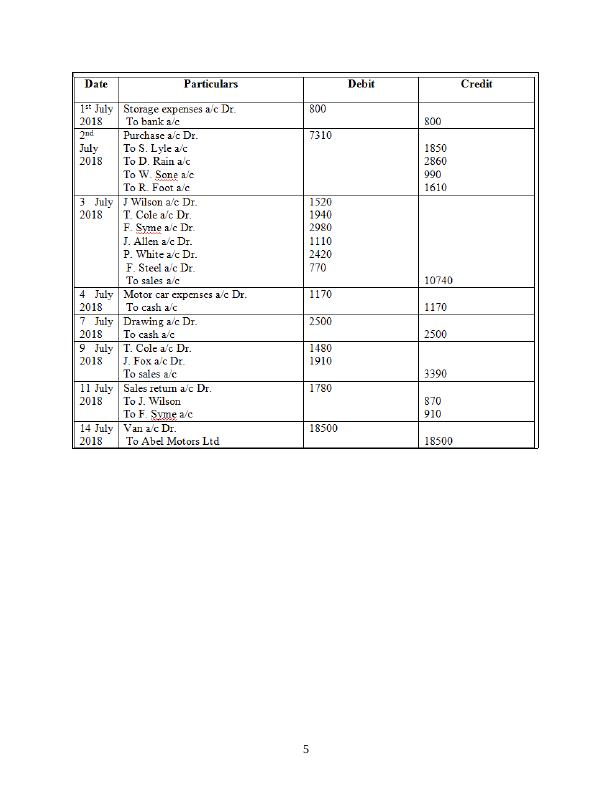
End of preview
Want to access all the pages? Upload your documents or become a member.
Related Documents
Financial accounting table of contents inTRODUCTION 1lg...
|39
|5192
|104
Financial Accounting Principles Doclg...
|39
|5227
|225
Financial Accounting Table of Contentslg...
|40
|4007
|130
Report on Accounting Conventions and Principleslg...
|34
|3968
|114
FINANCIAL ACCOUNTING INTRODUCTION 3 A. (A) Statement of financial position 20 (B)lg...
|30
|3307
|315
Financial Accounting - Sample Assignmentlg...
|22
|6586
|229
